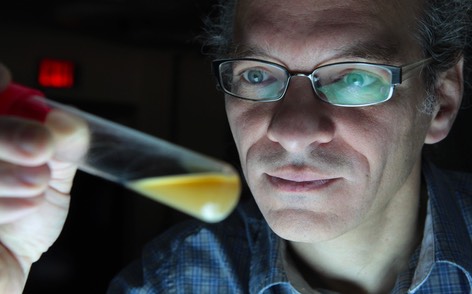Associate Professor, University of Minnesota

Dept. of Ecology, Evolution & Behavior, BioTechnology Institute
Ph.D. Michigan State University, 1993
Phone: 612-626-6201
Fax: 612-624-6777
Research Interests
Multicellularity, Evolution of Aging, Adaptive Radiation, Historical Contingency, Cooperation and Cheating, Experimental Evolution and Experimental Macroevolution, EvoDevo, Speciation
My long-term research goals are in understanding the causes of biological diversity and complexity. While natural selection is the ultimate cause for both, that level of explanation is not sufficient to understand how the myriad forms of life have come to exist. My research program is a series of studies of investigating increasingly more complicated biological systems. By understanding simple systems, we work toward understanding the evolution of complexity . Our first projects were with a single species of free-living bacteria, one of the simplest living systems that have biological complexity. Since those first experiments, our work has branched out to include simple eukaryotes, predator-prey interactions, and microbial communities.
Selected Publications
Ratcliff WC, Pentz JT, Travisano M. 2013. Tempo and mode of multicellular adaptation in experimentally-evolved Saccharomyces cerevisiae. Evolution
Love AC, Travisano M. Microbes modeling ontogeny. Biology and Philosophy 28(2):161-188.
Travisano M, Shaw RG. 2013. Lost in the map. Evolution 67(2):305-314.
Pérez-Gutiérrez R-A, López-Ramírez V, Islas Á, Alcaraz LD, Hernández-González I, Olivera BCL, Santillán M, Eguiarte LE, Souza V, Travisano M, Olmedo-Alvarez G. 2012. Antagoism influences assembly of a Bacillus guild in a local community and is depicted as a food-chain network. The ISME Journal 7:487-487.
Bonilla-Rosso G, Eguiarte LE, Romero D, Travisano M, Souza V. 2012. Understanding microbial community diversity metrics derived from metagenomes: performance evaluation using simulated data sets. FEMS Microbiology Ecology 82(1):37-49.
Escalante AE, Inouye S, Travisano M. 2012. A spectrum of pleiotropic consequences in development due to changes in a regulatory pathway. PLoS ONE 7(8):e43413.
Pajares S, Bonilla-Rosso G, Travisano M, Equiarte LE, Souza. 2012. Mesocosms of aquatic bacterial communities from the Cuatro Cienegas Basin (Mexico): A tool to test bacterial community response to environmental stress. Microbial Ecology 64(2):346-358.
Rebolleda-Gomez M, Ratcliff WC, Travisano M. 2012. Adaptation and divergence during experimental evolution of multicellular Saccharomyces cerevisiae. Artificial Life 13:99-104.
Souza V, Eguiarte LE, Travisano M, Elser JJ, Rooks C, Siefert JL. 2012. Travel, sex, and food: What's speciation got to do with it? Astrobiology 12(7):634-640.
Ratcliff WC, Denison RF, Borrello M, Travisano M. 2012. Experimental evolution of multicellularity. Proc. Natl. Acad. Sci. USA. 109(5): 1595-1600.
Goldman RP, Travisano M. 2011. Experimental evolution of ultraviolet radiation resistance in Escherichia coli. Evolution 65:3486-3498.
Saxer G, Doebeli M, Travisano M. 2010. The repeatability of adaptive radiation during long-term experimental evolution of Escherichia coli in a multiple nutrient environment. PLoS ONE 5(12):e14184.
Cox J, Shubert AM, Travisano M, Putoni C. 2010. Adaptive evolution and inherent tolerance to extreme thermal environments. BMC Evol Bio 10:75.
Ratcliff WC, Hawthorne P, Travisano M, Denison RF. 2009. When stress predicts a shrinking gene pool, trading early reproduction for longevity can increase fitness, even with lower fecundity. PLoS ONE 4(6):e6055.
Saxer G, Doebeli M, Travisano M. 2009. Spatial strcture leads to ecological breakdown and loss of diversity. Proc Biol Sci 276:2065-2070.
Quance G, Travisano M. 2009. Effects of temperature on the fitness cost of resistance to bacteriophage T4 in Escherchia coli. Evolution 63:1406-1416.
Waterland RA, Travisano M, Tahiliani KG, Rached MT, Mirza S. 2008. Methyl donor supplementation prevents transgenerational amplification of obesity. J Obesity 32:1373-1379.
McBride R, Greig D, Travisano M. 2008. Fungal viral mutualism moderated by ploidy. Evolution 62:2372-2379.
Greig D, Travisano M. 2008. Density-dependent effects on allelopathic interactions in yeast. Evolution 62:521-527.
Greig D, Travisano M. 2004. The Prisoner's Dilemma and polymorphism in yeast SUC genes. Proc R Soc Lond B Biol Sci. 271 Suppl 3:S25-6.
Travisano M, Velicer GJ. 2004. Strategies of microbial cheater control. Trends Microbiol. 12:72-8.
Greig D, Louis EJ, Borts RH, Travisano M. 2002. Hybrid speciation in experimental populations of yeast. Science 298:1773-5.
Rainey PB, Travisano M. 1998. Adaptive radiation in a heterogeneous environment. Nature 394:69-72.
Travisano M, Mongold JA, Bennett AF, Lenski RE. 1995. Experimental tests of the roles of adaptation, chance, and history in evolution. Science 267:87-90.
Lenski RE, Travisano M. 1994. Dynamics of adaptation and diversification: a 10,000-generation experiment with bacterial populations. Proc Natl Acad Sci U S A. 91:6808-14.
